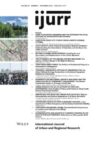In post-industrial cities in decline, what happens to leftover spaces after abandonment? This question lies at the root of trying to make sense of entrenched distress in neighborhoods in deindustrializing Detroit, a city struggling for more than five decades with disinvestment, job losses, population shrinkage, a collapsed housing market, abandoned properties and dysfunctional public services. Located on the west side of Detroit, Brightmoor and Delray are two neighborhoods that share common features of distress. Despite what might look like similarly neglected landscapes, the leftover spaces in these neighborhoods have not suffered the same fate, and what is happening has in fact diverged along alternative pathways. Making use of a relational comparison enables us to excavate beneath the level of appearances to expose entrenched differences. This investigation constructs layered profiles of these neighborhoods to counteract the erroneous misunderstandings that suggest that processes of decline put in motion by vacancy and abandonment have only produced lifeless voids where nothing happens, or empty slates where anything can happen. Rather, the uneven trajectories of urban decline in Brightmoor and Delray have left behind unanticipated residues that embed themselves in the social fabric of these neighborhoods, complicating conventional approaches to market-led stabilization and sustainable recovery.
Details
Written by:
Martin J. Murray, María Arquero de Alarcón, Olaia Chivite Amigo
Digital Object Identifier (DOI)
https://doi.org/10.1111/1468-2427.70019
About DOI
